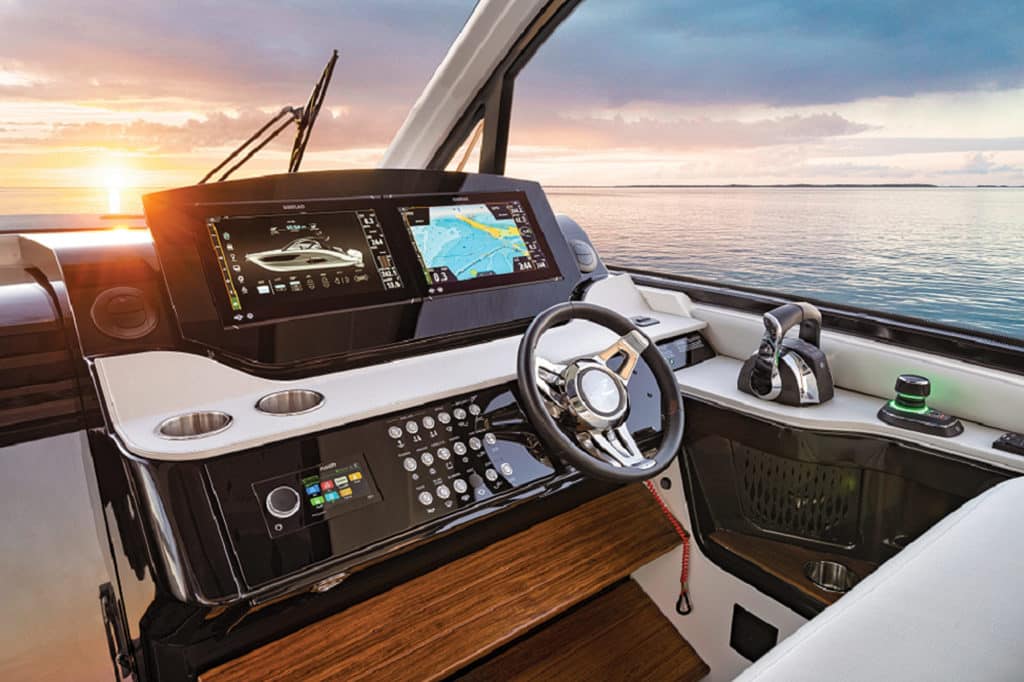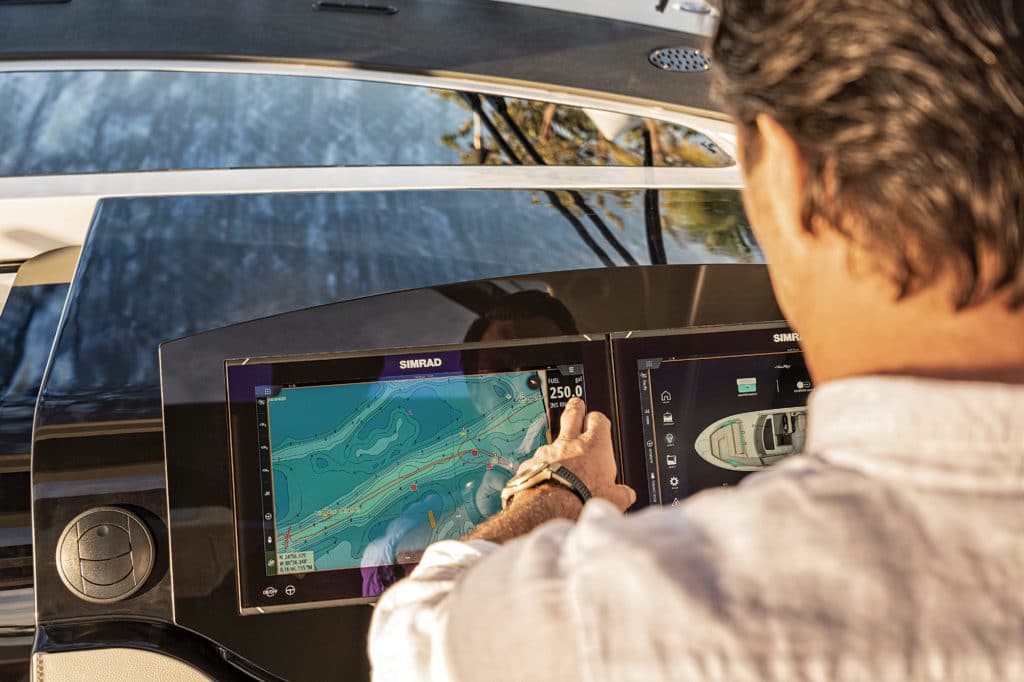
July 2019: A pick-and-place machine delicately but quickly tattoos microchips onto printed circuit boards at Navico’s production facility in Ensenada, Mexico. The machine looks like a miniaturized rotary cannon, with a mission to complete upward of 10,000 boards per day for B&G, Lowrance and Simrad products.
Standing there, I couldn’t discern what brand of equipment each batch of boards was destined for. While this reflects the integral role the boards play in marine electronics, it also reflects how deeply integrated these previously independent brands have become since they merged under a single roof.
October 2021: Brunswick Corp. announces that it has completed the acquisition of Navico in a $1.05 billion deal—rolling B&G, Lowrance and Simrad into Brunswick’s Advanced Systems Group.
It’s yet another new day for these brands—and for the whole marine-electronics landscape. While B&G, Lowrance and Simrad have all previously experienced acquisitions and reorganizations, Brunswick’s acquisition is poised to usher in a new era of integration among marine electronics, systems and yachts while allowing the brands to continue evolving under their existing leadership.
Brunswick consists of more than 60 brands that conduct business in four market segments. The company, which was founded in 1845 to build billiard tables, has been steadily increasing its marine interests since 1960. Brunswick’s other acquisitions include Bayliner, Boston Whaler and Sea Ray, and its portfolio includes Mastervolt, CZone, C-Map, Protector and Mercury’s four propulsion brands.

The addition of Navico “was a strategic acquisition for Brunswick to support their ACES strategy, which is really the future of a truly integrated boat system,” says Knut Frostad, Navico’s CEO, referring to Brunswick’s plan for autonomy, connectivity, electrification and shared access. “It helps Brunswick evolve that strategy and was the missing piece in the puzzle to offer an integrated, bow-to-stern solution.”
The acquisition also brings the Navico brands closer to their marine-industry roots. “We’ve obviously been owned in the past by financial investors, who have a different objective,” says Frostad, an accomplished sailor who served on Navico’s board for 14 years before being named CEO in 2019. “Now we’re owned by someone really strategic who understands the business.”
Brunswick’s investment in Navico goes much deeper than shared cultures, he adds.
“Electronics is obviously having more and more tentacles around the boat and is integrating with more elements of the boat,” Frostad says. “We have the opportunity to offer an integrated solution—much quicker and much better—because now we’re under the same roof with companies that offer these products on the same boats.”
The sailing-focused B&G brand may initially seem like a strange bedfellow in a corporation with a predominantly power-focused portfolio; however, Frostad says Brunswick sees sailing as a growth area.
“We’re using B&G today to develop some very interesting technologies that can be used in other parts of the marine industry, such as autopilots, where [competitive] sailing is very, very advanced compared to powerboats,” he says.
Smart autonomous or semi-autonomous vessels may be coming in the future. But for now, B&G, Lowrance and Simrad brand identities will remain, and Navico-branded equipment will be spec’d on Brunswick-built boats if Navico offers the best technical solution. Otherwise, Brunswick-owned boatbuilders are free to spec third-party equipment.
One example of third-party partnerships is DockSense (see Yachting, June 2019), a collaboration among Raymarine, Boston Whaler and Mercury that delivered the world’s first integrated smart docking-assist product.
Frostad envisions a similar future for Navico. “It’s really about coming up with an offering that’s outstanding in the industry, that’s the right offering and the right product and the right services at the right time,” he says.
In addition to harboring shared aspirations for creating connected vessels, Brunswick and Navico share other core values too. “I’ve taken Navico on a sustainability journey that’s very ambitious and that goes very deep into what sustainable boating is in the future,” Frostad says. “Brunswick has really mirrored that strategy. … Now we have multiple touch points for the same customers. That enables us to have a bigger footprint on the boat, but we can also collaborate on offering a better service.”
Moving forward, B&G, Lowrance and Simrad customers can expect further integration of their electronics and the rest of their yacht in ways that are intended to make boating better, safer and more sustainable. Much like the factory-line integration that I witnessed in Ensenada, in time, boaters aren’t likely to know exactly where their equipment’s innovations stem from, only that these advances enhance the boating experience.
A Company is Born
The histories are rich: In 1947, Willy Christian Simonsen founded Simonsen Radio in Oslo, Norway. Simrad Yachting was purchased by the Kongsberg Group in 1996; in 2003, Simrad Yachting acquired B&G, the sailing-instrument manufacturer. In 2003, the Kongsberg Group sold Simrad Yachting to Altor Equity Partners, a Swedish private-equity firm. In 2005, Altor purchased Lowrance, a Tulsa, Oklahoma-based firm. Navico was created in 2006 when Altor merged the three.









